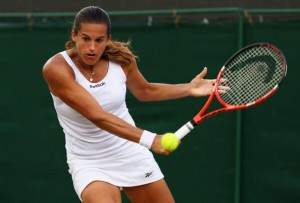Will Amelie Mauresmo Leave Tennis Behind?
Headlines whispered earlier this week that Frenchwoman Amelie Mauresmo was considering retirement from tennis. At the age of 30, it may seem that Mauresmo has been around forever. She has, in fact, been playing tennis professionally for 16 years.
According to Peter Scrivener’s BBC report, Mauresmo stated “Since the U.S. Open, I’ve been trying to practice but I can’t seem to find the desire to come back to competition…I don’t want to rush or force things. I will take some time to think before making a decision regarding the remainder of my career.”
It is not the first time that Mauresmo has used the press to announce her intention or a change in her life.
Although it raised a few eyebrows and created a stir in the locker room, Mauresmo’s admission in 1999 that she is a lesbian brought another kind of pressure to bear on the young woman—then aged 19.
The fact that Martina Hingis called her “half a man” and Lindsay Davenport actually stated that she felt Mauresmo played like a man were remarks dismissed by the young Frenchwoman. She felt that coming out enabled her to be successful on the tennis court—this according to Kathy Beige, About.com.
Amelie Mauresmo was born in Laye, France on July 5, 1979. According to all the sources, little Amelie watched Yannick Noah win the 1983 French Open and fell in love with the game of tennis. She asked for and received a tennis racket from her parents and began to develop her natural talent.
More than most women on tour, Mauresmo is an exceptionally talented athlete. She moves effortlessly, covers the court with speed and agility, engaging with finesse and touch as well as power. She is renowned for her one-handed backhand and her net play.
Like many players with great natural ability, Mauresmo did not have the career her talent dictated. She seemed to fall short during the big matches much like Hana Mandlikova did in the ’80s and Dinara Safina does currently.
During the big moments her courage and her will faded as nerves overcame her natural instincts causing her to falter at the finish line.

Mauresmo became the number one ranked player in the world in 2004 and won the Australian and Wimbledon titles in 2006.
Mauresmo did play fine tennis during most matches. As testament to that fact, Mauresmo rose to the No. 1 ranking in 2004, which also saw her win a silver medal for France during the Summer Olympics.
For Mauresmo, the dominant backhand stroke was both a curse and a blessing. It was by far the best shot in her arsenal, but every one of her opponents realized that and either did not allow her to use it or prepared for it, knowing it was Mauresmo’s weapon of choice.
As she moved into her best years from late 2003 through 2006, the Frenchwoman learned to utilize her forehand, making it more dependable and giving her the opportunity to employ the backhand when it best suited her game.
By being more selective with that shot, Mauresmo’s entire game became stronger. If her backhand misfired, she had someplace else to go, some other shot to depend on when needed.
One of the other facets of her game Mauresmo improved enabling her to reach the top of the women’s game dealt with her tendency to stand back behind the baseline. True, Mauresmo grew up playing on clay—and clay-ballers tend to employ that stance.
But Mauresmo had tremendous ability to volley and play well at the net. By advancing close to the baseline and moving forward, the Frenchwoman was able to develop that net play skill and integrate it into her game. It gave her more opportunity to be aggressive and take over rallies quicker.
In 2006, she won the Australian Open and the Wimbledon Championship, both times upending Justine Henin. On March 20, 2006, Mauresmo briefly regained the No. 1 ranking and held it for most of the remainder of that year.
Illness and injury kept Mauresmo sidelined during 2007, and she dropped out of the top five, where she had been a staple since November of 2003. Being ill and injured, she could not maintain her training regimen, leaving her unfit and unable to compete.
She opened 2008 struggling to regain her form. In the end, she never quite managed to overcome lingering injuries. In September, she split with her coach, Loic Courteau. She ended the year ranked 24th without ever gaining back her edge on the court.
It appeared that 2009 was going to be different—different than 2008, in any case. Mauresmo won her first tournament by defeating Elena Dementieva in the finals of the Open GDF Suez Tournament in Paris. It was to be her last tournament win of the year.
The Frenchwoman competed well to the middle of events, no longer even making it to the finals. She announced her decision to consider her retirement on Oct. 8, 2009.
Should Mauresmo retire from the game, it would mean one less woman playing comfortably at the net. While not regarded strictly as a serve-and-volley player, one of Mauresmo’s core strengths was her net play.
Her natural athletic ability allowed her to succeed there where many of the current top players could not. Serve-and-volley players will fade into the past until someone figures out how to counter the obvious advantage of staying back. It is one of the most interesting of tennis cycles.
Mauresmo will make her decision before the resumption of 2010 tennis activities as to whether she will continue to play tennis. But such a momentous decision need not be final…just ask Justine Henin.
JA Allen is a regular contributor to Sports Then and Now.










